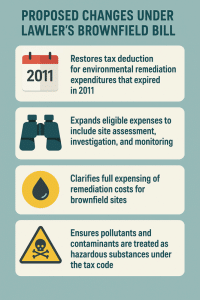 Contributed by Charles Ray, Brownfields Specialist, PPM Consultants
Contributed by Charles Ray, Brownfields Specialist, PPM Consultants
For more than 24 years, I’ve been working with the EPA Brownfields Program, and I spent nearly two decades with the City of St. Petersburg as its Economic Development Coordinator. During that time, I saw firsthand how the right tools and community involvement can turn an abandoned or polluted property into a place that benefits people again — whether that’s new housing, a local business, or green space.
That’s why I paid close attention when Congressman Mike Lawler from New York’s 17th District introduced the Brownfield Revitalization and Remediation Act in September 2025. His bill brings back tax incentives that expired years ago and makes some important updates to help communities and developers actually move brownfield projects forward.
Let’s take a look at who Congressman Lawler is, what’s in this bill, and some of the challenges that will come with it.
Who is Congressman Mike Lawler?
 Congressman Lawler represents communities just north of New York City — places with a mix of old industrial areas and growing suburbs, not unlike many communities I’ve worked with in Florida and across the Southeast. He’s known as one of the most bipartisan members of Congress and has built a reputation for getting things done.
Congressman Lawler represents communities just north of New York City — places with a mix of old industrial areas and growing suburbs, not unlike many communities I’ve worked with in Florida and across the Southeast. He’s known as one of the most bipartisan members of Congress and has built a reputation for getting things done.
This new bill makes sense for him. It’s practical, not flashy. It’s designed to give local governments, developers, and business owners tools they need to clean up contaminated land and put it back into use. That’s something every community can get behind.
Why This Bill Matters Now
Back in the early 2000s, there was a federal tax deduction that helped offset cleanup costs at brownfield sites. But that program expired in 2011, and since then, a lot of communities have had fewer financial options. EPA grants are wonderful, but they don’t reach everyone.
What’s happened is that too many polluted properties have just sat there — eyesores, safety hazards, and lost opportunities. Congressman Lawler’s bill brings those tax incentives back and expands them in a way that makes sense.
What the Bill Proposes
Here’s a simple breakdown of the four big changes in the Brownfield Revitalization and Remediation Act:
- Bringing Back the Tax Deduction
The bill restores the old tax deduction that let developers and communities write off cleanup expenses. That means the cost of cleaning up a brownfield could once again be reduced by lowering tax bills.
The Challenge: The tricky part here will be the “retroactive” piece. The bill allows deductions for projects started in 2025, but businesses that already filed taxes this year may have to amend their returns or wait for IRS guidance. That could slow things down until rules are crystal clear.
- Expanding What Counts as Eligible Expenses
Under the old law, only direct cleanup costs qualified. Lawler’s bill adds assessments, investigations, and monitoring — the stuff we do early in the process to figure out what’s there and how bad it is. This is a big deal because you can’t fix what you don’t understand.
The Challenge: The question will be where to draw the line. For example, does a basic soil assessment count? What about more advanced studies? Without clear definitions, there could be confusion between taxpayers and the IRS. Communities and developers will need to keep really good records to prove these costs belong in the cleanup column.
- Allowing Full Expensing of Cleanup Costs
Instead of spreading deductions out over years, this bill says you can deduct the full cost of cleanup in the year you spend it. That’s a boost for cash flow and could help more projects pencil out financially.
The Challenge: Environmental cleanups don’t usually wrap up in one neat calendar year. Costs often stretch out over phases. The IRS will need to clarify how to treat expenses that spill over multiple years. Developers will need accountants and project managers talking to each other to make sure the timing is handled right.
- Clarifying What Counts as a Hazardous Substance
The bill makes sure that pollutants and contaminants are treated as hazardous substances under the tax code. It sounds small, but it helps avoid confusion about whether cleanup costs qualify.
The Challenge: Science keeps moving, and new contaminants like PFAS get added to the list of concerns. The hardest part will be keeping the tax code aligned with EPA’s rules. If the law doesn’t keep up, we could find ourselves back in the same gray area.
Why This Bill Matters for Communities
Every time a brownfield site is cleaned up and reused, it’s a win — fewer environmental hazards, safer neighborhoods, and new opportunities for growth. Congressman Lawler’s bill doesn’t create new red tape; it simply restores and updates a tool that worked before.
That’s the kind of practical change I’ve always believed in. When I worked in St. Petersburg, we didn’t just talk about brownfields in terms of contamination — we looked at them as chances to bring people back together. Parks, shops, jobs, homes: those were the real outcomes. And those outcomes only happen when policy matches the realities of how redevelopment works.
How PPM Can Help
At PPM Consultants, we live and breathe this work. We help communities, developers, and businesses understand what’s in the soil, how to manage it, and how to turn challenges into opportunities. With decades of brownfield experience — from federal programs to local economic development — I know how complicated these projects can get. But I also know the payoff is worth it.
The Brownfield Revitalization and Remediation Act is one more reminder that the time to plan is now. Whether the bill passes exactly as written or with changes, it shows that momentum is building to make brownfield redevelopment easier. If your community has an abandoned or polluted site, we can help you chart the path forward. Brownfields may start as yesterday’s problems, but with the right tools — and the right partners — they can become tomorrow’s opportunities. Congressman Lawler’s bill is a step in that direction. For more information on how PPM can help make redevelopment a reality for your community, contact us!

